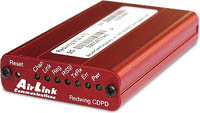Cellular Communications / REDWINGCDPD
RETIRED ›
This product is not available for new orders. We recommend ordering: RV50.
This product is not available for new orders. We recommend ordering: RV50.

| Services Available | |
|---|---|
| Repair | No |
| Calibration | No |
| Free Support | No |
Overview
The RedwingCDPD supported telecommunications between a data logger and a cellular digital packet data (CDPD) network. This CDPD modem was IP based; the cellular provider needed to assign an IP address for the site. The Redwing had many of the same features as its predecessor, the Raven II.
The RedwingCDPD modem was retired 11 March 2004 because of the discontinuation of CDPD services.
Images

Compatibility
Note: The following shows notable compatibility information. It is not a comprehensive list of all compatible or incompatible products.
Data Loggers
| Product | Compatible | Note |
|---|---|---|
| 21X (retired) | ||
| CR10 (retired) | ||
| CR1000 (retired) | ||
| CR10X (retired) | ||
| CR200X (retired) | ||
| CR206X (retired) | ||
| CR211X (retired) | ||
| CR216X (retired) | ||
| CR23X (retired) | ||
| CR295X (retired) | ||
| CR3000 (retired) | ||
| CR500 (retired) | ||
| CR5000 (retired) | ||
| CR510 (retired) | ||
| CR800 (retired) | ||
| CR850 (retired) | ||
| CR9000 (retired) | Although the CR9000X and CR9000 are compatible, the RedwingCDPD does not support their fastest communication rates and therefore is not practical for most of their applications. | |
| CR9000X (retired) | Although the CR9000X and CR9000 are compatible, the RedwingCDPD does not support their fastest communication rates and therefore is not practical for most of their applications. |
Specifications
| Transmit Power | 600 mW |
| Transmit | 824 to 849 MHz |
| Receive | 869 to 894 MHz |
| Data Rates | 19.2 kbps via TCP/IP, 1,200 to 38,400 bps via serial interface |
| Input Voltage | 9 to 30 Vdc |
| Input Current | 30 to 450 mA |
| Typical Current Drain @ 12 Vdc |
|
| Operating Temperature Range | -30° to +70°C (with transmissions limited to a 10% duty cycle above 60°C) |
| Humidity | 5% to 95% (non-condensing) |
| RF Protocol | CDPD 1.1 |
| Serial Interface | RS-232, DB-9F |
| RF Antenna Connector | 50 ohm TNC female |
| Serial Protocols | AT Commands, SLIP, PPP |
| Status LEDs | Power, Channel Acquired, Link Status, Network Registration, RSSI, Transmit/Receive, Block Errors |
Privacy Policy Update
We've updated our privacy policy. Learn More
Cookie Consent
Update your cookie preferences. Update Cookie Preferences